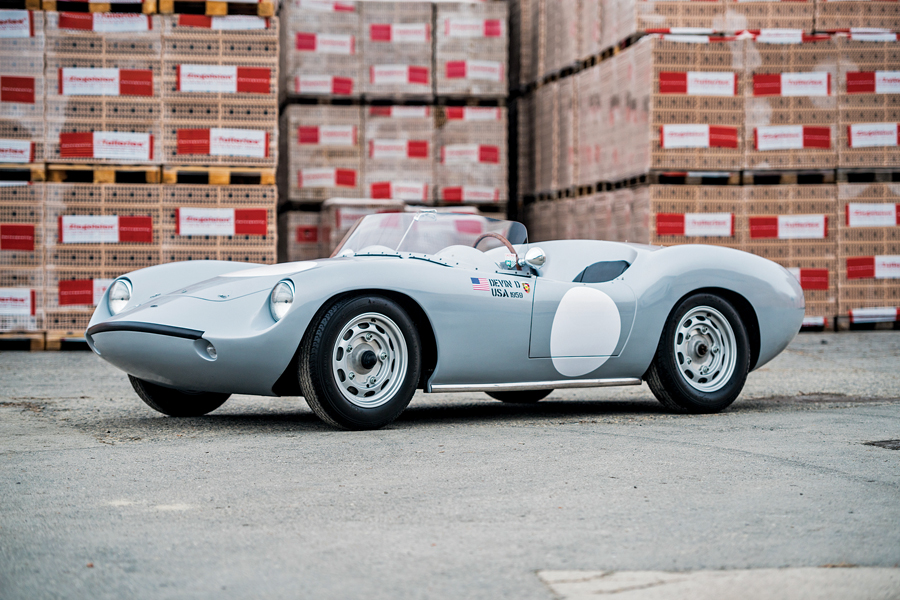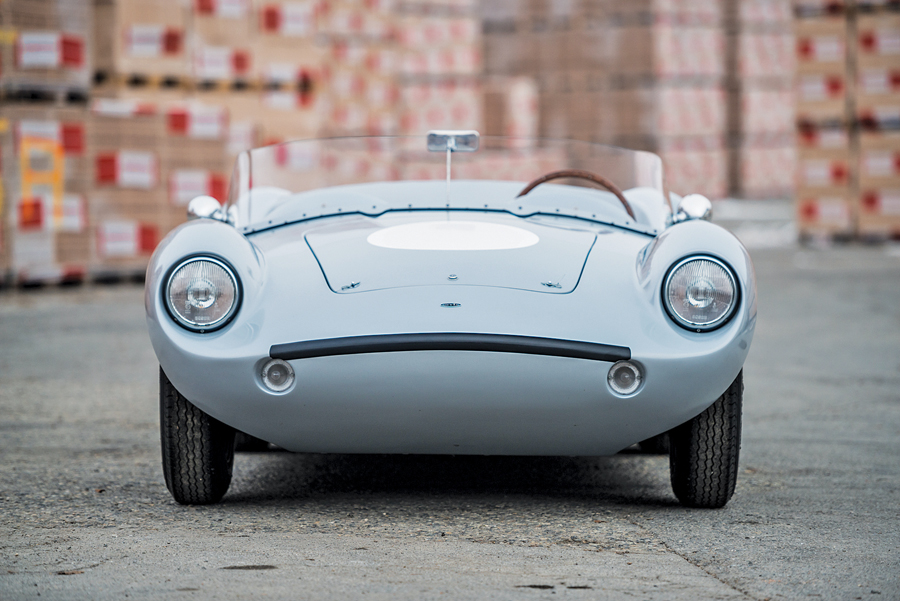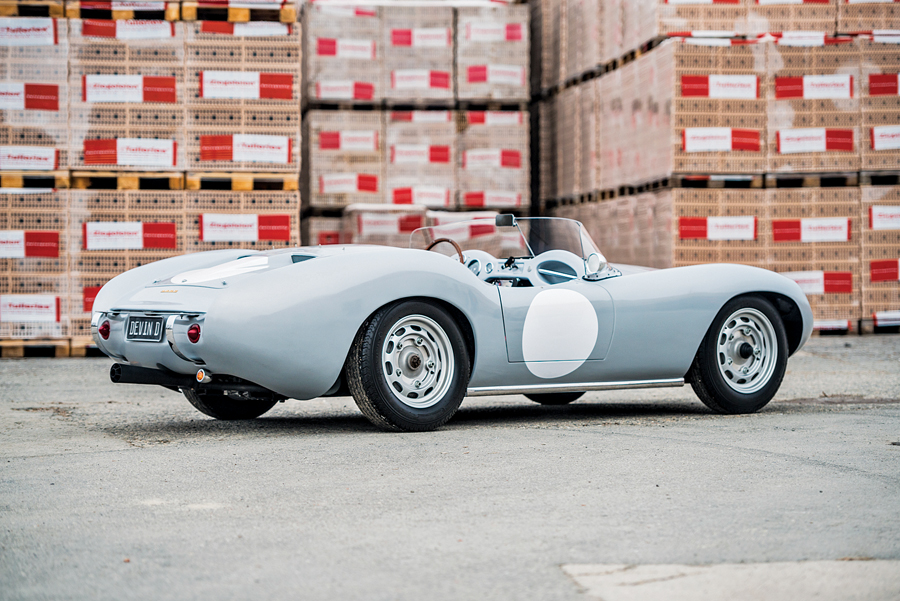SCM Analysis
Detailing
| Vehicle: | 1959 Devin D Porsche Special |
| Years Produced: | 1958–65 |
| Number Produced: | Factory-built cars, 46; kits, unknown |
| Original List Price: | $3,500 |
| SCM Valuation: | $78,375 |
| Chassis Number Location: | Top of engine fan shroud |
| Engine Number Location: | Above crankshaft pulley |
| Club Info: | Porsche Club of America |
| Website: | http://www.pca.org |
| Alternatives: | 1959–65 Devin C, 1960–63 Porsche 356B, 1956–58 Lotus Eleven |
| Investment Grade: | B |
This car, Lot 213, sold for $88,000, including buyer’s premium, at RM Sotheby’s auction on Amelia Island, FL, on March 11, 2017.
The kit car is a uniquely American phenomenon. Although certain English manufacturers, such as Lotus, were happy to sell disassembled versions of their production cars as a way of avoiding an excise tax on automobiles, the idea of selling bodies and various parts to hobbyists to use in constructing their own specials was a product of our post-World War II enthusiasm and the hot rod culture that developed in the United States.
A number of factors — economic, administrative, and cultural — joined in a happy confluence to allow this, and it is worth a bit of time to consider how it happened. The economics are pretty simple: The U.S. was physically untouched during the war and emerged with an enormous industrial, financial and agricultural base.
Building your own car
After a few tough years making the transition from a wartime environment to a peacetime one, the American economy boomed as probably never before. Jobs were available to virtually anyone who wanted one, and the relatively low cost of living (and possibly expectations following 15 years of extremely difficult times) meant that lots of people had spare cash to spend.
The administrative side is less obvious except in retrospect.
Today we accept the idea that government should set and enforce standards for most aspects of our lives as completely normal, but this hadn’t been imagined in the 1950s. In the car world, this made for very simple times — no safety requirements or crashworthiness, no emissions or fuel-efficiency rules, no standardized vehicle identification systems, no real legal obligations to build or operate a safe and roadworthy car, no such thing as a “secure title.” Getting a car licensed and street legal involved little more than fenders, headlights, and filling out a form at the state license bureau.
Anybody could build, register and sell a car.
A can-do mindset
The cultural aspects were possibly the most important. America felt that it had saved the world in the war, and the troops came home optimistic, enthusiastic, and with the feeling that they could accomplish whatever they set their minds to. There was also a tacit assumption that they could do anything a lot better.
In the car world this gave us hot rods. Is what you can buy too boring and slow? Go ahead and chop it, channel it, stuff in a big engine, paint it up in wild colors, then go and show your friends what you’ve done. There’s no reason not to.
The ease of fiberglass
The last big factor was the invention of the fiberglass auto body, which became a viable alternative in the early 1950s. Forming steel into a body requires tremendous investments in tooling and presses, so it is impractical for low production, while aluminum requires lots of time and artistry to get fluid shapes, but anyone willing to build a mold can build a fiberglass body. It democratized small-quantity car production.
Bill Devin was one of the first and certainly the most successful of the kit-car builders. He was a serial entrepreneur who started out as a small-time car dealer and quickly caught the racing bug — he entered a Crosley Hotshot in the early Pebble Beach races. He graduated to selling Siatas, Ferraris and OSCAs in Southern California, but he became disillusioned with their cost, unreliability, and general unsuitability for both the street and competition uses that his clients wanted.
In other words, Devin was sure that he could do it better.
He learned how to work in fiberglass and started out building H-modified racers based on Panhard components on a custom ladder frame. Not claiming to be a designer, he took a body mold off a DB Le Mans car for the shape and used high-quality woven glass cloth to build a very strong and light body. These Devin-Panhards proved successful and paved the way to the next step: building and selling the components for a kit car.
He started out this phase in 1956 with a body shape that he had lifted off a friend’s 1,100-cc Ermini, a Scaglietti design that looked like a scaled-down 750 Monza Ferrari. The trick that made it work was that instead of a single-piece mold, he made lots of differently sized mold pieces that could be assembled into a single tool to produce any of 27 differently sized bodies for anything from a Crosley through an MG to a Corvette. Devin Enterprises became the biggest aftermarket body manufacturer in the world.
In 1957, two Irish engineers who wanted to purchase a body for a chassis they had designed approached Devin. Rather than just sell them a body, he arranged to purchase their chassis design and entered the complete car business with the Chevy V8-powered Devin SS (also available as a kit). The SS used a new body shape that was similar to the kit cars but distinct. It continued in production through 1959.
Enter the Model D
Building on the success of both the body business and the SS, Devin introduced the Model D in 1958. It used a Devin-designed-and-built tubular ladder frame, a newly designed body, and Volkswagen engine, transaxle and suspension. The idea was that someone moderately handy with wrenches could take a VW sedan, purchase a $1,500 frame, body and accessories kit, and build a complete sports car.
Or you could buy a Devin-built model for $3,000. Production continued through 1965. I have no idea how many kits were produced or sold, but the factory apparently built 46 cars. Porsche power was optional for about $500.
More Porsche than VW
Today’s subject car is unquestionably a Devin D, almost certainly built from a kit rather than by the factory, and apparently was very carefully and well constructed. The question for both performance and value has to do with how much 356 Porsche is inside vs. VW sedan. Because of design similarities, it shouldn’t be difficult to use a Porsche suspension rather than VW, and this car has a 356 Super 90 engine. It clearly uses Porsche wheels and brake drums, and the instruments are Porsche. If someone took a wrecked Super 90 and moved all the essential bits over to the new chassis, the end Devin will be far different and more desirable than if it had VW suspension, transaxle and steering. A 1,350-pound, 90–100-horsepower open Porsche 356 with Devin frame and body could be a lot of fun.
This is speculation on my part, but my guess is that this car is more Porsche than VW.
It was previously part of a major Swiss collection, and the Italian “356 Club” tag on the body suggests that knowledgeable eyes have inspected and approved of it. If this is true, then the price makes quite a lot of sense.
Garden-variety Devin Ds seldom come up, and when they do they are under $35,000 — maybe. Add, say, $20,000 for the Porsche engine, and you still don’t have much value. If you can think of valuing it as a weird, pretty and very quick 356, though, the money makes sense. I’d guess the latter, so fairly bought. ♦
(Introductory description courtesy of RM Sotheby’s.)


